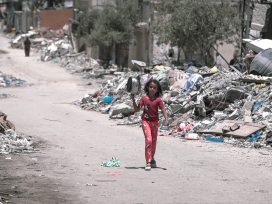Pictures, provocation, and free expression
The decision of some European newspapers to reprint the Mohammed cartoons smacked of arrogance and moral posturing, says Ian Jack, editor of Granta. What did we learn from them that was worth risking so much anger and disaffection?
Let’s set aside the question of the principle of freedom of expression for a moment, and consider the cartoons of the Prophet pragmatically.
One thing publishers and editors have to ask themselves when faced with the prospect of publishing something highly contentious or inflammatory is: what good will it do? I suppose Flemming Rose, the culture editor of the Danish newspaper Jyllands-Postens, must have asked himself that question when the cartoons of the Prophet – cartoons he had commissioned – landed on his desk in the late summer of 2005. It’s hard to tell from reports just how inflammatory Rose realized these cartoons would be. All he has said is that he wanted to start “a debate” about how compatible Islam was with the values of a modern, secular society. However, the several other newspapers in Europe that published the cartoons after the storm broke knew very well what they were doing. It was as though they were saying: “We don’t care how much it gets up Muslim noses, this is how we behave in Europe, these are our rules, when in Rome…” etc. You might even say they were posturing; many publishers and editors love a good moral posture, the chance to look principled and brave. France-Soir (which sacked its editor) mentioned the values of Voltaire and the French Revolution in an editorial, but I thought Jack Straw, Britain’s foreign secretary, was right when he described the cartoons’ republication as “insulting, insensitive, disrespectful and wrong”.
The second question a publisher or editor should ask himself is the opposite of the first: what harm will it do? Will it endanger life, including the lives of the newspaper’s staff? Will it alienate and anger a sizeable section of the community? In this case, will it deepen perhaps the world’s greatest and most violent division, between Islam and the West? Will it cause riots and petrol-bombing from Luton to Indonesia? Will it confirm the prejudice and fear of many Muslims that the West is out to get them and that we don’t give a fig for their religious feelings or taboos? In short, will it make the world a less happy and more dangerous place? I don’t think the culture editor of Jyllands-Postens could have spent much time on these questions, what you might too-mildly call the downside of his decision to put the cartoons in his paper. Maybe Denmark seems far away from the bombs and the wars (though it has troops in Iraq and many Muslim migrants in its towns). If the answers to the above – a resounding yes in each case – came as a surprise to him he must have led a very sheltered life. Not only did the cartoons depict the Prophet (sacrilegious to most Muslims in itself) but one or two of them depicted him as a terrorist. Jyllands-Postens might just as well have had added a line below its masthead: “The paper that is looking for trouble, see page 53.”
As for the principle of freedom of expression, it depends how absolute you want to be. The principle isn’t and has never been indivisible. The law rightly inhibits it. The editor of Die Welt, the German newspaper that published the cartoons, spoke strongly on television about how Muslims and other migrants needed to realize that European tradition puts nothing beyond satire, until he was reminded of the Holocaust. Perhaps the memory of the Holocaust is now the nearest thing the West has to the old religious idea of the sacred; in several countries, you can go to jail for denying it, just as you could once be hanged for denying the Christian God. Britain’s blasphemy law is still for some reason on the statute books of a country that doesn’t recognize the word. It is Europe’s underestimation of the power of religious sacrilege – especially the force it still has among practising Muslims – that has led to so much trouble.
Many things need to be argued with the Muslim populations of Europe, not least the rights of women, but the cartoons were no way to pursue such an argument. It was the equivalent of spitting at your partner. What did we learn from them that was worth risking so much anger and disaffection? That Muhammad wore a turban. In a volatile situation where enmity and distrust are increasing, their publication was reckless and stupid. By not reproducing them, at least not as I write, the British media did the right, respectful, and pragmatic thing.
Published 16 February 2006
Original in English
First published by www.indexonline.org (will appear in Index on Censorship 1/2006: "Small Wars You May Have Forgotten")
Contributed by Index on Censorship © Ian Jack/Index on Censorship Eurozine
PDF/PRINTNewsletter
Subscribe to know what’s worth thinking about.



